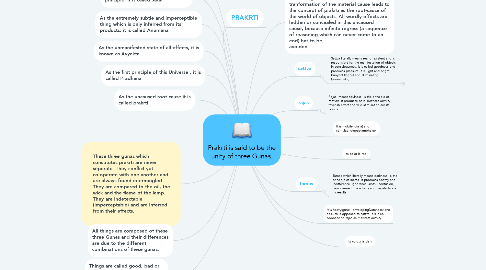Prakrti is said to be the unity of three Gunas.
por shagun fatima


1. As the ever-active unlimited power, it is called Shakti.
2. As the unintelligent and unconscious principle, it is called Jada
3. As the extremely subtle and imperceptible thing which is only inferred from its products; it is called Anumana
4. As the unmanifested state of all effects, it is known as Avyakta
5. As the first principle of this Universe , it is called Pradhana
6. These three gunas which constitutes prakrti are never seperate. They conflict yet co-operate with one another and are always found intermingled. They are compared to the oil, the wick and the flame of the lamp. They are indetectable (imperceptable) and are inferred from their effects.
7. All things are composed of these three Gunas and their differences are due to the different combinations of these gunas.
8. Things are called good, bad or indifferent ; intelligent, active or slothfull ; pure , impure or neutral, on account of the predominance of sattva , rajas and tamas respectively.
9. As the uncaused root cause it is called prakrti
10. PRAKRTI
11. The thoery that causation means a real tranformation of the material cause leads to the concept of prakrti as the root-cause of the world of objects. All wordly effects are hidden or concealed in this uncaused cause, because infinite regress (a sequence of reasoning which can never come to an end) has to be avoided.
12. Its colour is dark
13. It is heavy(guru) , enveloping(varanaka) and as such is opposed to sattva. It is also opposed to rajas as it arrests activity.
14. Its color is red.
15. It is mobile (chala) and stimulating(upastambhaka).
16. sattva
16.1. Sattva literally means real or existent and is responsible for the manifestation of objects in consciousness. It is called goodness and produces pleasure. It is light and bright, buoyant (laghu) and illuminating (prakashaka).
16.1.1. luminosity of light, power of reflection , upward movement, pleasure , happiness , contentment , bliss are all due to it.
16.1.1.1. Its color is white.

